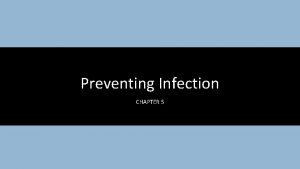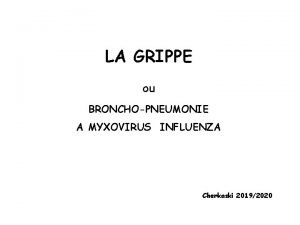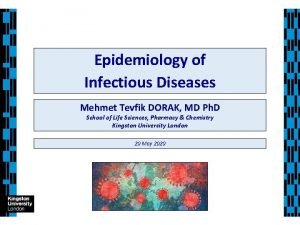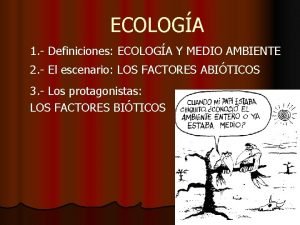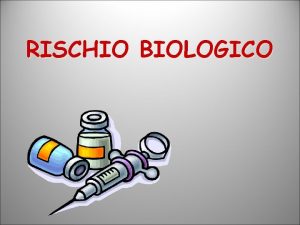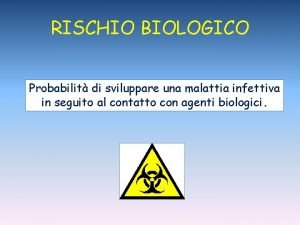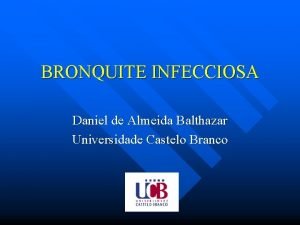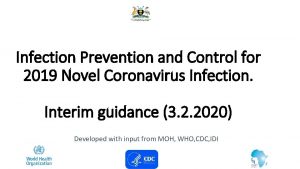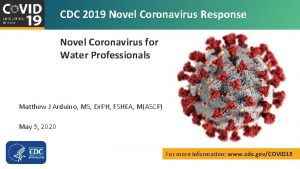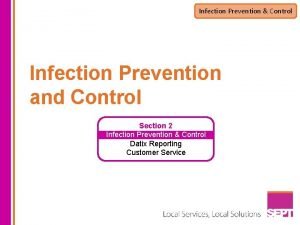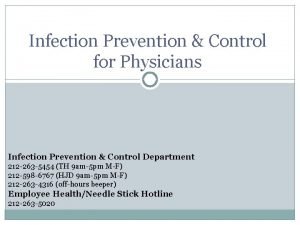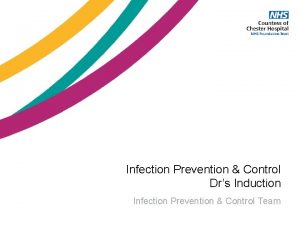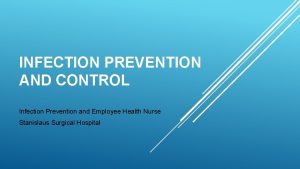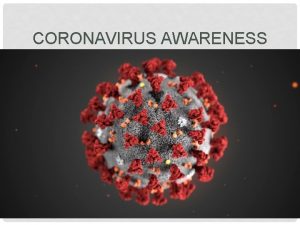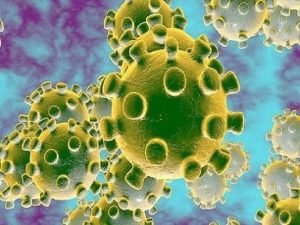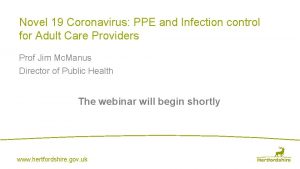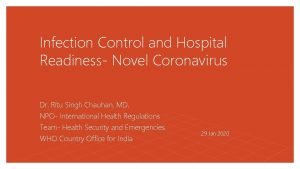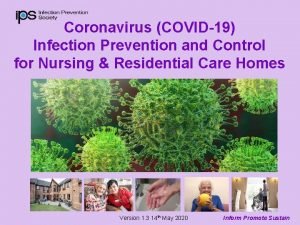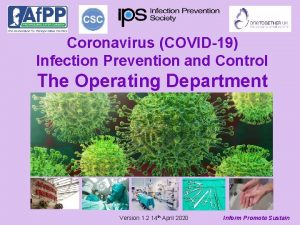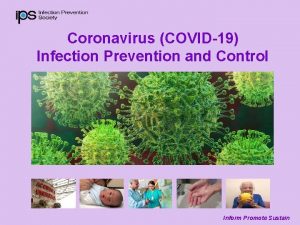Infection Prevention and Control for 2019 Novel Coronavirus

















- Slides: 17

Infection Prevention and Control for 2019 Novel Coronavirus Infection. Interim guidance for Home care Developed with input from MOH, WHO, CDC, IDI 1

Objectives • To guide health workers, care givers and discharged/suspect patients on the procedures for home isolation • To provide an understanding of the environmental conditions suitable for home care • To guide the care givers, patients and health workers on the standard IPC precautionary measures. • To provide guidance on management of asymptomatic contacts 2

Introduction Home care isolation guidelines are provided for: • Patients who have been discharged from the health facility • Situations when inpatient care is unavailable • In instances of limited capacity and resources unable to meet demand for health care services. 3

Symptoms Most common symptoms can include: • Fever • Cough • Shortness of breath For confirmed 2019 -n. Co. V infections, reported illnesses have ranged from people with little to no symptoms to people being severely ill and dying. Severe symptoms • Pneumonia, • severe acute respiratory syndrome • kidney failure • Acute renal Injury • Acute cardiac Injury • Respiratory failure • Acute Respiratory distress syndrome (ARDS) -17 -29% of hospitalised patients in China • Secondary infection/superinfection reported 4

An assessment of home care environment is essential. This decision requires careful clinical judgment and should be informed by assessing the safety of the patient’s home environment 5 WHO Infection prevention and control of epidemic and pandemic-prone acute respiratory infections. pdf

Communication linkages • Daily contact health care provider should be established for the full duration of the home care period. • Contact can be made by phone and, ideally and if feasible, by face-toface visits on a regular (e. g. daily basis) • Inform health authorities to coordinate with National/regional labs to perform specific diagnostic tests as necessary. 6

Information for household members • Should be educated on personal hygiene • Clean surfaces and objects that may be contaminated with germs. • Wash your hands often with soap and water for at least 40 -60 seconds and dry them. If soap and water are not available, use an alcohol-based hand rub with at least 60% alcohol if available or 0. 05% chlorine solution. • Use dedicated linen and eating utensils for the patient; these items should be cleaned with soap and water after use and may be re-used instead of being discarded • The patient and family should be provided with ongoing support, education and monitoring 7

Recommended practices at home Social distance • Place the patient in a well-ventilated single room. Ensure that shared spaces (e. g. kitchen, bathroom) are well ventilated (e. g. keep windows open). • Limit the number of caretakers of the patient, ideally assign one person who is in a good health without risk conditions. Restrict visitors. • Household members should stay in a different room or, if that is not possible, maintain a distance of at least 2 m from the ill person (e. g. sleep in a separate bed) 8

Recommended practices at home Use of masks • The caregiver should wear a tightly fitted Medical mask that covers her/his mouth and nose when in the same room with the patient. The ill person should have a medical mask on when interacting with others. • If the mask gets wet or dirty with secretions, it must be replaced immediately with a new, clean, dry mask. Remove the mask by using appropriate technique (i. e. do not touch the front but remove the lace from behind). • Discard the mask after use and perform hand hygiene after removal of the mask. 9

Recommended practices at home Hand hygiene • Perform hand hygiene following all contact with ill persons or their immediate environment. • Hand hygiene should also be performed before and after preparing food, before eating, after using the toilet, and whenever hands look dirty. • If hands are not visibly soiled, alcohol based hand rub can be used. • When using soap and water, disposable paper towels to dry hands is desirable. If not available, use dedicated cloth towels and replace them when they become wet. 10

Recommended practices at home Respiratory hygiene • Respiratory hygiene refers to covering the mouth and nose during coughing or sneezing using medical masks, cloth masks, tissues or flexed elbow, followed by hand hygiene. • Should be practiced by all, especially ill persons, at all times. • Discard materials used to cover the mouth or nose or clean them appropriately after use (e. g. wash handkerchiefs using regular soap or detergent and water). Waste disposal • Gloves, tissues, masks and other waste generated by ill persons or in the care of ill persons should be placed in a lined container in the ill person’s room before disposal by burning in a pit. 11

Recommended practices at home PPE • Avoid direct contact with body fluids, particularly oral or respiratory secretions, and stool. • Use disposable gloves to provide oral or respiratory care and when handling stool, urine and waste. • Perform hand hygiene before and after removing gloves. • Use disposable gloves and protective clothing (e. g. plastic aprons) when cleaning or handling surfaces, clothing or linen soiled with body fluids. • Appropriate use of masks: Medical masks for symptomatic patients and an N 95 mask for caregivers 12

Recommended practices at home Contacts A contact is a person in any of the following: • Health care-associated exposure, including providing direct care for n. Co. V patients, working with health care workers infected with n. Co. V, visiting patients or staying in the same close environment of a n. Co. V patient. • Working together in close proximity or in the environment with a 2019 -n. Co. V patient. • Traveling together with 2019 -n. Co. V patient in any kind of transportation. • Living in the same household as a n. Co. V patient within a 14 -day period after the onset of symptoms in the case under consideration. Monitor their health for 14 days from the last day of possible contact. In the event that the clinical picture deteriorates, admission to hospital should be considered 13

Recommended practices at home Cleaning and disinfection • Clean frequently touched surfaces such as bedside tables, bedframes, and other bedroom furniture daily with regular household disinfectant containing a diluted bleach solution • Clean and disinfect bathroom and toilet surfaces at least once daily with a diluted chlorine solution containing 0. 5% sodium hypochlorite or hot water • With gloves, wash clothes, bedclothes, bath and hand towels, etc. of ill persons using regular laundry soap and water • Do not shake soiled laundry and avoid direct contact of the skin and clothes with the contaminated materials 14

Management of contacts • The healthcare provider should give advance instructions on where to seek care when a contact becomes ill, mode of transportation, and what infection control precautions should be followed. • Notify the receiving medical facility that a symptomatic contact will be coming to their facility. • While traveling to seek care, the ill person should wear a medical mask. • Avoid public transportation to the health care facility. if possible; call an ambulance or transport the ill person with a private vehicle and open the windows of the vehicle if possible. 15

Management of contacts • The ill contact should be advised to always observe respiratory hygiene and hygiene; stand or sit as far away from others as possible (at least 2 m), when in transit and when in the health care facility. • Any surfaces that become soiled with respiratory secretions or body fluids during transport should be cleaned and disinfected with regular household containing a diluted bleach solution 16

References • Infection prevention and control of epidemic- and pandemic prone acute respiratory diseases in health care. Geneva: World Health Organization; 2014 (WHO/CDS/EPR/2007. 6; https: //www. who. int/csr/bioriskreduction/infection_control/pu blication/en/, accessed 14 January 2020). • WHO guidelines on hand hygiene in health care. Geneva: World Health Organization; 2009 (WHO/IER/PSP/2009/01; http: //apps. who. int/iris/handle/10665/44102, accessed 13 June 2018). • Home care for patients with suspected novel coronavirus (2019 -n. Co. V) infection presenting with mild symptoms and management of contacts. Interim guidance 04 February 2020 17
 Primary prevention secondary prevention tertiary prevention
Primary prevention secondary prevention tertiary prevention Chapter 16 infection prevention and control
Chapter 16 infection prevention and control Chapter 19 disease transmission and infection prevention
Chapter 19 disease transmission and infection prevention Chapter 19 disease transmission and infection prevention
Chapter 19 disease transmission and infection prevention Chapter 19 disease transmission and infection prevention
Chapter 19 disease transmission and infection prevention Define infection prevention chapter 5
Define infection prevention chapter 5 Scissurite coronavirus
Scissurite coronavirus Relazione finale classe quinta scuola primaria
Relazione finale classe quinta scuola primaria Mehmet tevfik dorak
Mehmet tevfik dorak Factores abióticos
Factores abióticos Rischio biologico coronavirus | titolo x d.lgs. 81/08
Rischio biologico coronavirus | titolo x d.lgs. 81/08 Rischio biologico coronavirus | titolo x d.lgs. 81/08
Rischio biologico coronavirus | titolo x d.lgs. 81/08 Bronquite coronavirus
Bronquite coronavirus Chapter 16 infection control and standard precautions
Chapter 16 infection control and standard precautions Infection control principles and practices milady
Infection control principles and practices milady Cbic recertification
Cbic recertification Extraoral radiography ppt
Extraoral radiography ppt Chapter 15:3 washing hands
Chapter 15:3 washing hands





